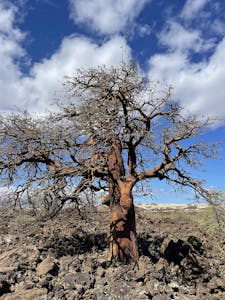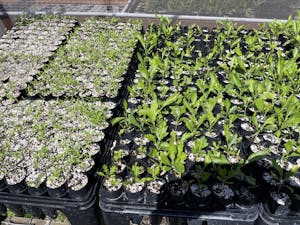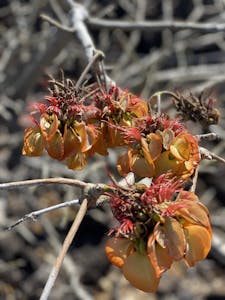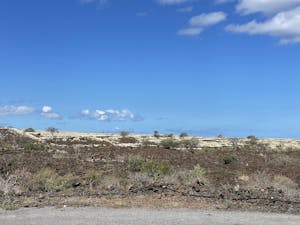TALK STORY: Wiliwili Trees on the Wild West Coast of Hawaiʻi Island
Beginning in 2019, Body Glove Cruises partnered with CarbonBuddy to allow guests to offset the carbon emissions produced by their tour. When making a reservation online, make sure to check that $1 contribution checkbox; donations are given back to the community to support organizations like our friends at the Waikōloa Dry Forest Initiative. We took a hike with this community-driven nonprofit to “talk story” about their operation.
Check out our blogs on our other CarbonBuddy partners: Hawaiʻi ‘Ulu Cooperative and Hawaiʻi Community Assets!
–
Located on a backroad just outside of Waikōloa Village is a 275-acre nature preserve dedicated to rebuilding the rare Native Hawaiian lowland dry forest ecosystem. The terrain is covered in jagged lava, called aʻa in Hawaiian — an unlikely venue for a forest, but nonetheless, is home to a plethora of endangered native trees. In 2011, the Waikōloa Dry Forest Initiative (WDFI) undertook the care of this community-owned property after several years of doing preservation work under the name of The Outdoor Circle. Their mission focus started small: wiliwili trees.
Wiliwili trees (Erythrina sandwicensis) are one of the few deciduous trees native to Hawaiʻi. They are charismatic and eccentric, characterized by their coarse trunks, vibrant sunset-colored flowers, and the twisted seed pods that give the tree its name (in Hawaiian, wiliwili translates to “twisty-twisty”!). Culturally significant and useful to the indigenous people of Hawaiʻi, the lightweight, buoyant wood was used in the construction of canoes (waʻa) and their outriggers (ama), surfboards (heʻe nalu), and fishnet floats (pīkoi).

This wiliwili tree is affectionately called Hi’ilalo. In Hawaiian, this means to carry a baby on the front of the body, because of the tree’s location at the front of the preserve. However, it also means to see one’s loved ones returning, signifying the return of the dry forest.
Unfortunately, wiliwili trees, like many other native species, are in decline. Present threats the wiliwili face include goats, wildfires, and gall wasps.
Feral goats, which prefer dryer habitats, run amuck in the region the Waikōloa Dry Forest Reserve calls home. Goats were introduced to the islands by Captain James Cook in 1778, and because Hawaiʻi does not have native grass-grazing animals, native and endemic plants have no natural defenses against ungulates. Feral goats are the catalyst to the extinction of many native plans. To protect the reserve from these insatiably hungry caprines, the Initiative built a 3.5-mile long goat-proof fence around the perimeter.
The land between Waimea and Waikōloa is especially subject to wildfire breakouts, which is worsened by the fact dry forests receive less than 50” of rain and longer dry seasons each year. At the time of our tour with WDFI in August, the forest had received just 2” of rain, with an average of 11”. In 2021, the largest wildfire in the state’s history ripped through 40,000 acres of land. All WDFI could do was prepare as much as they could and pray for the reserve’s safety at the time. Fortunately, despite high winds, the preserve remained untouched by the flames, and WDFI received an outpouring of support and concern as the Waikōloa community held its breath.
Fountain grass thrives after wildfires and through long droughts. Despite the long stalk burning away during a fire, the part of the plant responsible for germination remains afterwards. Because fountain grass is one of the first to return after a fire, it overtakes the growth of native plant species. The best way to tackle fountain grass growth is after a fire. In 2008, WDFI hit the plant with herbicide before it could grow back.

In the rare case that a tree dies, the Waikōloa Dry Forest Initiative donates the wood and resources back to the community, so that it may be repurposed and continue its life in another form.
One of the worst threats to the wiliwili tree is the erythrina gall wasp (EGW). This invasive insect burrows into the tissue of the bright red seed buds and lays its eggs. This infestation causes stress to the host, and results in rapid death. Countermeasures have been deployed against this wasp, and it’s an unlikely foe: another wasp! The eurytoma parasitoid wasp seeks out gall wasp eggs so that its own larvae may feed on the EGW larvae. Nowadays, gall wasp invasions rarely result in tree death, but still pose a threat during flowering season. Their infestation can result in low seed production, among other issues.
Despite all of this, wiliwili trees are quite resilient. Healthy seedlings can sit dormant until conditions are ripe for growing. Once a dry spell comes to its end and the first rains come, the wiliwili trees spring back to life and come into bloom! The forest’s wet season lasts through winter until March, much like the humpback whales’ visitation. New trees are planted with the first rains.

A Hawaiian proverb reads, “Pua ka wiliwili nanahu ka manō,” meaning, “When the wiliwili blooms, the sharks will bite.” This saying connects the wiliwili’s blooming (wet season) with the pupping season of tiger sharks, which overlap, and the sharks become more aggressive.
The Waikōloa Dry Forest Initiative emphasizes it is not trying to cultivate a garden; they do not water the propagated plants. Instead, they are attempting to replicate what a true, native ecosystem might look like — without the invasive species. Our host at the reserve, Jen Lawson, was drawn to the opportunity to continue her lifelong work in endangered species conservation, but also to integrate the community into what she did each day. Each summer, WDFI runs a summer camp, the ‘Āina Explorers, and during the school year, they change gears to an after-school program: The Future Foresters. This program fosters keiki (children) through place-based education, where they may adventure, learn, and reflect in nature.
Visitors and locals alike can get involved with the Waikōloa Dry Forest Initiative! Support by adopting a wiliwili tree. A tree will be planted in the donor’s honor, and afterwards, they receive a certificate and GPS location of their tree. On island, stop by the preserve and join the free First Friday Huakaʻi (hike), hosted year-round at sunset. Additionally, stop by the pop-up thrift shop at the Waikōloa Stables, the Dusty Donkey Emporium (open Tuesdays, Thursdays, and Saturdays). All money supports WDFI’s efforts.
CHECK THIS COOL THING OUT: Hawaii Forest & Trail is operating a Maunakea Summit & Stars Giveback Experience. On the way to the summit of Maunakea, stop at the Waikōloa Dry Forest Preserve to participate in conservation work. $20 of every ticket is donated directly to WDFI. This is part of the ecotourism movement, which offsets the negative impact of tourism by giving back to the local community. Give us a call at (808)326-7122, and weʻll help you set up a tour with our partner, Hawaii Forest & Trail!
Written by: Keisha Colon





